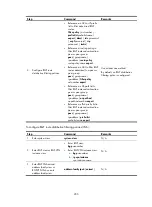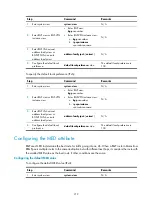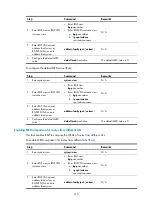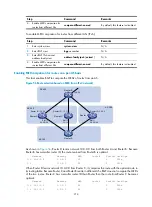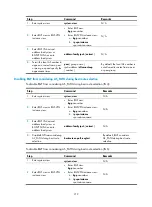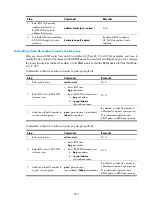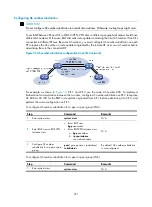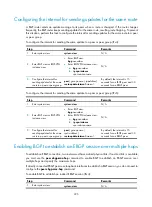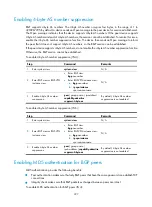
218
To configure the NEXT_HOP attribute (IPv6):
Step Command
Remarks
1.
Enter system view.
system-view
N/A
2.
Enter BGP view.
bgp
as-number
N/A
3.
Enter BGP IPv6 unicast
address family view.
address-family ipv6
[
unicast
]
N/A
4.
Specify the router as the next
hop for routes sent to a peer
or peer group.
peer
{
group-name
|
ipv6-address
}
next-hop-local
By default, the router sets itself as
the next hop for routes sent to an
EBGP peer or peer group, but does
not set itself as the next hop for
routes sent to an IBGP peer or peer
group.
Configuring the AS_PATH attribute
Permitting local AS number to appear in routes from a peer or peer group
In general, BGP checks whether the AS_PATH attribute of a route from a peer contains the local AS
number. If yes, it discards the route to avoid routing loops.
In certain network environments (for example, a Hub&Spoke network in MPLS L3VPN), however, the
AS_PATH attribute of a route from a peer must be allowed to contain the local AS number. Otherwise, the
route cannot be advertised correctly.
To permit the local AS number to appear in routes from a peer or peer group and specify the
appearance times (IPv4):
Step Command
Remarks
1.
Enter system view.
system-view
N/A
2.
Enter BGP view or BGP-VPN
instance view.
•
Enter BGP view:
bgp
as-number
•
Enter BGP-VPN instance view:
a.
bgp
as-number
b.
ip vpn-instance
vpn-instance-name
N/A
3.
Enter BGP IPv4 unicast
address family view or
BGP-VPN IPv4 unicast
address family view.
address-family ipv4
[
unicast
]
N/A
4.
Permit the local AS number to
appear in routes from a peer
or peer group and specify the
appearance times.
peer
{
group-name
|
ip-address
}
allow-as-loop
[
number
]
By default, the local AS number is
not allowed in routes from a peer
or peer group.
To permit the local AS number to appear in routes from a peer or peer group and specify the
appearance times (IPv6):


